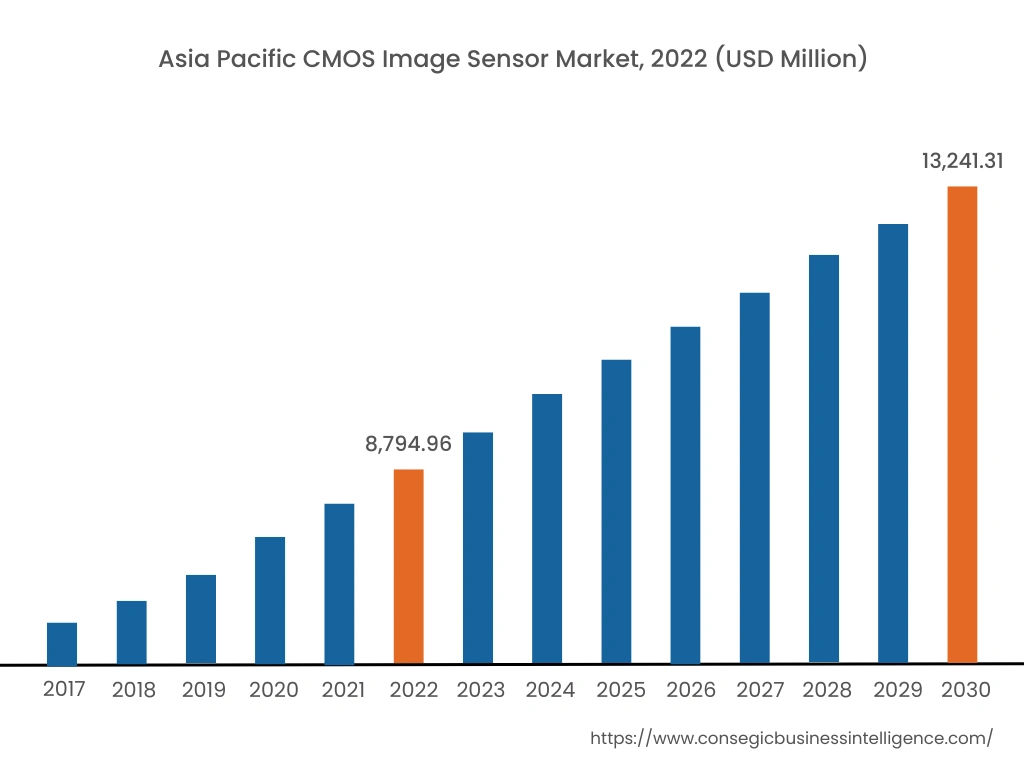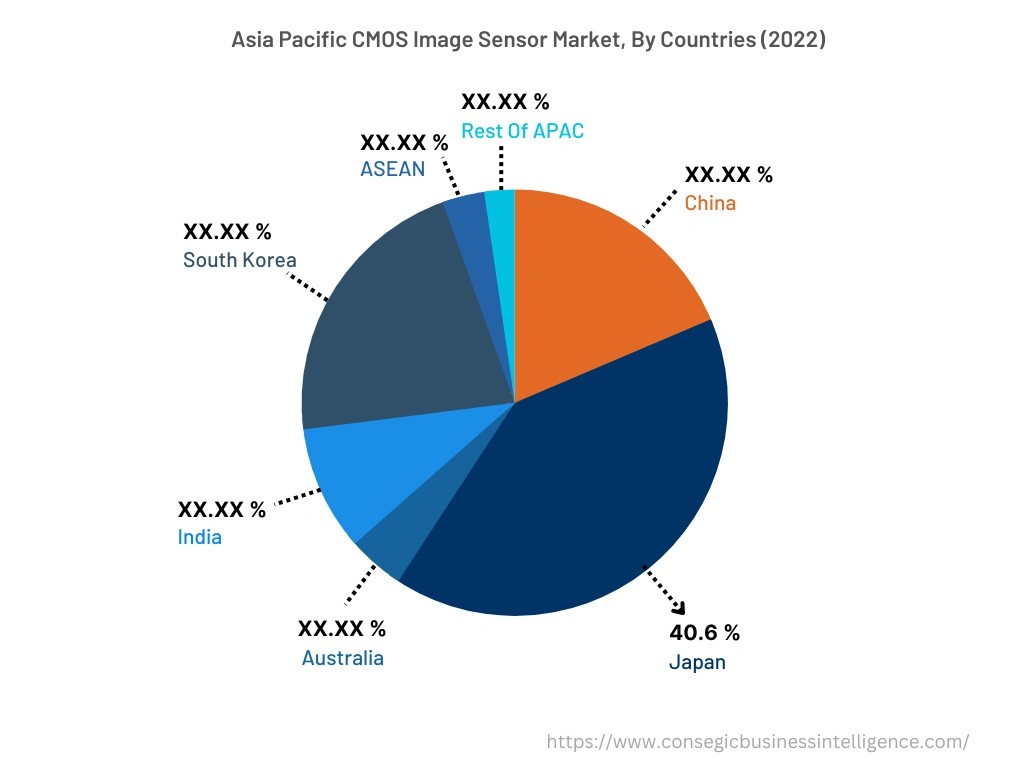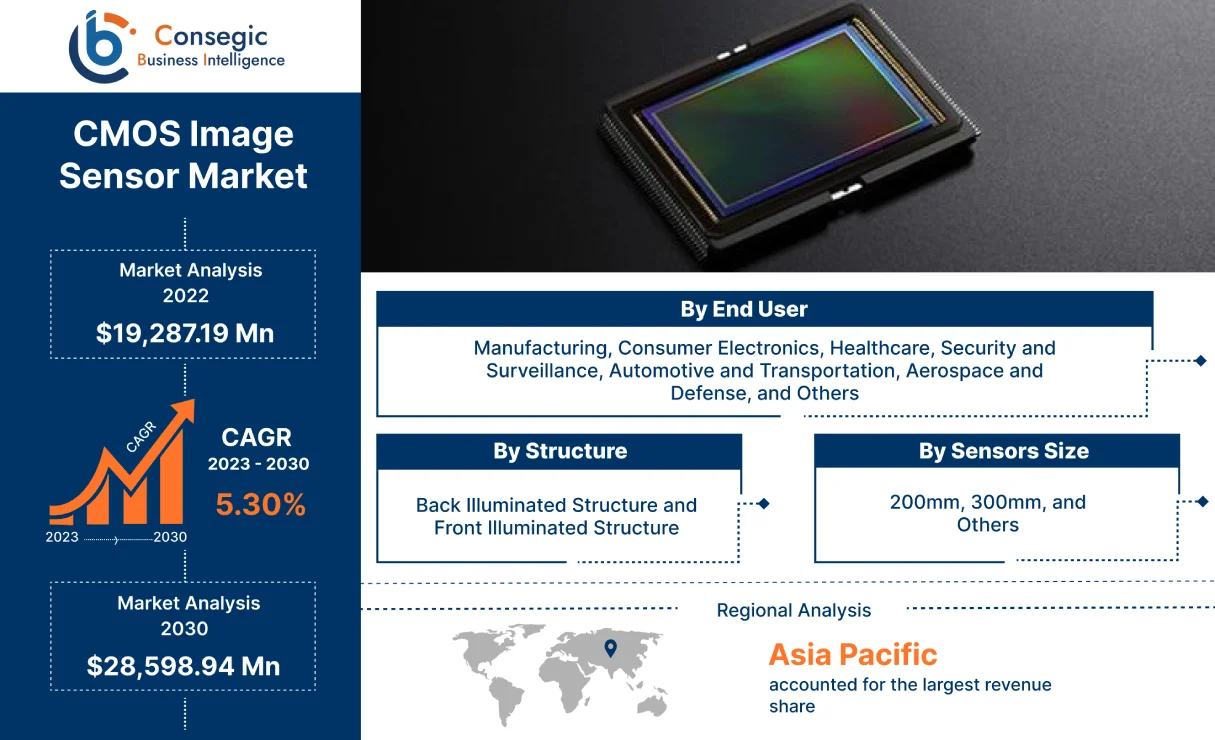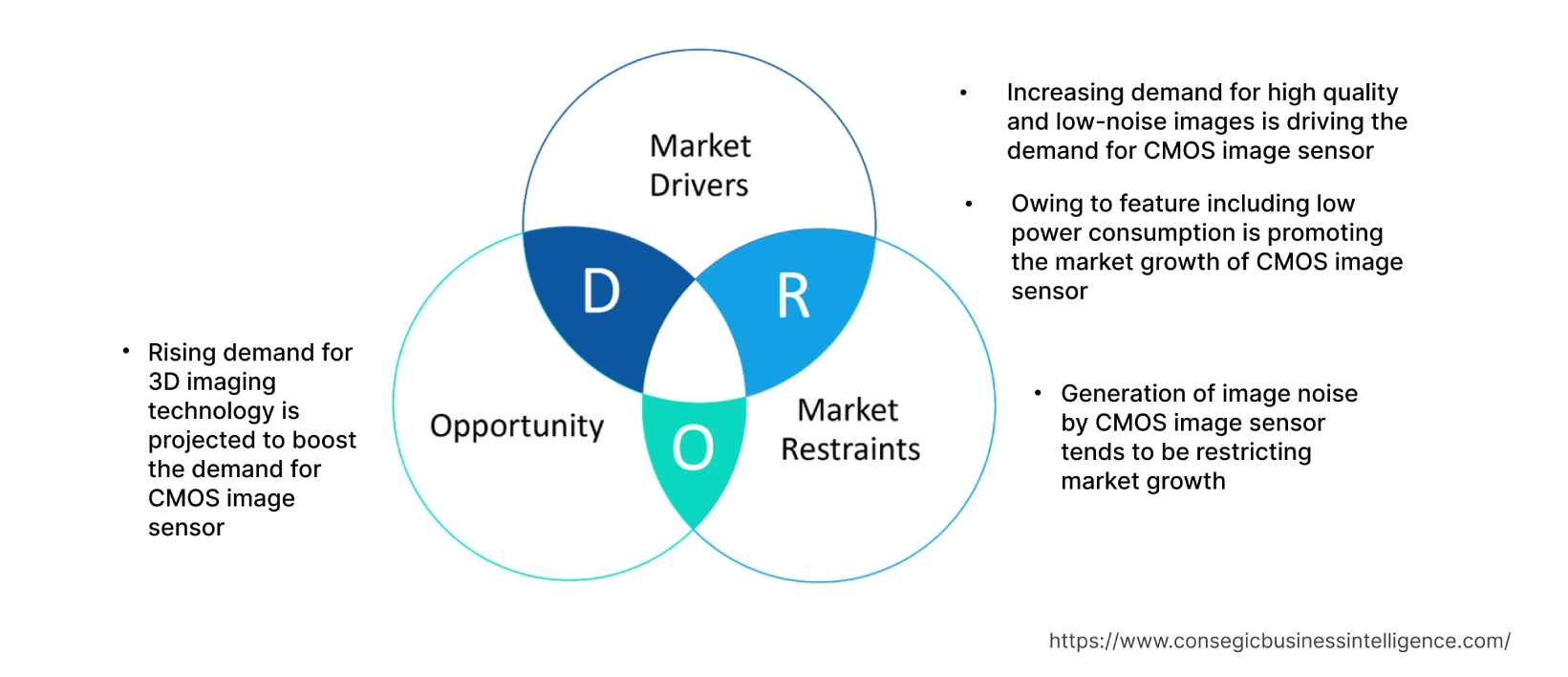CMOS Image Sensor Market Size :
CMOS Image Sensor Market size is estimated to reach over USD 28,598.94 Million by 2030 from a value of USD 19,287.19 Million in 2022, growing at a CAGR of 5.30% from 2023 to 2030.
CMOS Image Sensor Market Scope & Overview:
CMOS Image Sensor, also known as Complementary Metal-Oxide-Semiconductor is a type of image sensor that converts light into electrical signals, thus producing digital images. The key function of CMOS includes signal amplification, photodetection, charge conversion, analog to digital conversion, and others. Moreover, as per the analysis, these sensors are capable of converting amplified signals from analog to digital format by means of assigning discrete numerical values to represent different levels of light intensity.
Furthermore, CMOS sensor consists of amplifier in each pixel, which allows the device to consume less power complemented with faster processing of signals. In addition, the evolution of CMOS technology has enabled its widespread adoption in applications including smartphones, digital cameras, security cameras, among others.
CMOS Image Sensor Market Insights :
Key Drivers :
Increasing demand for high quality and low-noise images is driving the market
CMOS sensors have evolved with widespread applications in comparison to CCD (Charged Coupled Device) technology in terms of producing high quality images. In addition, CMOS offers advantages over CCD including lower cost, lower voltage operation, and on-chip functionality. The key factors attributed towards the rise in requirement for these sensors include its applications in digital photography, medical, space, industrial vision, 3D vision systems, among others.
Moreover, with the growing trend towards these sensors for larger pixel size in smartphones, digital cameras, among others, are propelling CMOS image sensor market trends. In addition, as per the analysis, few other benefits being offered by CMOS sensors include reduced camera size due to inbuilt read-out-logic in the same chip coupled with low energy consumption. Since, reduced energy consumption tends to produce less heat resulting in formation of better image quality is therefore driving the market expansion .
For instance, Canon introduced LI5030SAC and LI5030SAN images sensors capable of producing 19 megapixel images that are ideal for industrial and monitoring applications.
Owing to feature including low power consumption is promoting the market expansion
Low power consumption facility by CMOS sensors is facilitated due to their design and operational characteristics. The key features include readout mechanisms that allow individual pixels to be activated and read separately, allowing the device to minimize power consumption. Each pixel present at different levels minimizes power consumption by only activating the pixel that are required for image capture thus avoiding energy waste and generating excess heat.
Moreover, as per the analysis, pixel architecture containing each pixel has its own amplifier and circuitry that enables the sensor to amplify and process the signal directly at the pixel level. Accordingly based on aforementioned architecture, the analog signal from each pixel takes less processing time in transmitting signals over a longer distance thus reducing the potential for signal degradation and minimizing power consumption. Thus, these factors are driving the market trends.
Key Restraints :
Generation of image noise by CMOS image sensor market tends to be restricting market
CMOS image sensor are subjected to produce high noise based images in comparison to CCD based sensors. Owing to the presence of analog to digital converter (ADC) and additional amplifier in the circuit tend to produce noise in the image. Few other related concerns include high dark current, high fixed pattern noise (FPN), and poor sensitivity also tends to produce noise in the final output of the image. Moreover, as per the analysis, based on several other factors noise in an image can be divided into pixel noise, column amplifier noise, ADC, and among others. Pixel noise is type of noise mainly caused by photon shot dark current shot, and among others. Therefore, owing to the aforementioned noise types and its generation at different levels of pixels is hindering the market.
Future Opportunities :
Rising requirement for 3D imaging technology is projected to create opportunities in the forecast year
CMOS image sensor has contributed towards the development and advancement of 3D imaging technology which is creating lucrative CMOS image sensor market opportunities and trends in the coming years. The key feature of providing accuracy in capturing of depth information by these image sensor is fuelling its demand in 3D imaging technology. In addition, the application of CMOS sensor includes Time-of-Flight (TOF) imaging, structured light imaging, among others is expected to promote the CMOS image sensor market growth during the forecast period.
Moreover, technology such as TOF employes image sensors to calculate depth by measuring the time taken for the light to travel from the camera to the subject and its reversal. Furthermore, with the expansion of healthcare industry and rising demand for MRI scans that inculcates 3D imaging will further employ the demand for CMOS image sensor market trends during the forecast period.
CMOS Image Sensor Market Report Insights :
| Report Attributes | Report Details |
| Study Timeline | 2017-2030 |
| Market Size in 2030 | USD 28,598.94 Million |
| CAGR (2023-2030) | 5.30% |
| By Structure | Back Illuminated Structure and Front Illuminated Structure |
| By Sensors Size | 200mm, 300mm, and Others |
| By End User | Manufacturing, Consumer Electronics, Healthcare, Security and Surveillance, Automotive and Transportation, Aerospace and Defense, and Others |
| By Region | North America, Europe, Asia-Pacific, Latin America, and Middle East & Africa |
| Key Players | Canon, Inc., STMicroelectronics, Samsung Electronics Co. Ltd., Semiconductor Components Industries, LLC, SK Hynix, Inc., Sony Corporation, Omnivision Technologies, Inc., Hamamatsu Photonics K.K., Panasonic Corporation, Teledyne DALSA, JAI A/S, and Olympus Corporation |
| Geographies Covered | |
| North America | U.S. Canada Mexico |
| Europe | U.K. Germany France Spain Italy Russia Benelux Rest of Europe |
| APAC | China South Korea Japan India Australia ASEAN Rest of Asia-Pacific |
| Middle East and Africa | GCC Turkey South Africa Rest of MEA |
| LATAM | Brazil Argentina Chile Rest of LATAM |
| Report Coverage | Revenue Forecast, Competitive Landscape, Growth Factors, Restraint or Challenges, Opportunities, Environment & Regulatory Landscape, PESTLE Analysis, PORTER Analysis, Key Technology Landscape, Value Chain Analysis, Cost Analysis, and Regional Trends & Forecast |
CMOS Image Sensor Market Segmental Analysis :
By Structure :
Based on the structure, the market is bifurcated into back illuminated structure and front illuminated structure. The back illuminated structure segment is accounted for the largest revenue share in the year 2022. The segment is also projected to garner fastest CAGR during the forecast period. Factor attributed towards the expansion of back illuminated structure segmented is faster signal and recording process, reduced noise, better sensitivity to low light conditions, among others. Moreover, as per the analysis, the growing demand for better cameras to capture images at low light conditions from devices including smartphones, digital cameras, and others is fuelling the market growth. For instance, α7R IV 35 mm full-frame mirrorless camera with 61.0 MP offered by Sony contains back illuminated structure for better image quality. Thus, the aforementioned factors are propelling the trends of the market.
By Sensors Size :
Based on the sensors size, the market is bifurcated into 200mm, 300mm, and Others. 200mm segment is accounted to generate largest CMOS image sensor market share of 56.6% in the year 2022. Moreover, 200mm segment is also projected to grow at the fastest growth rate during the forecast period. Factors include growing demand for better image quality among devices including smartphones, digital cameras, surveillance cameras, astronomical devices, and others. 200mm image sensor is based on its fabrication, which is primarily done on 200mm diameter of silicon wafer. As per the analysis, owing to improved quality being offered by 200mm sensor size and comparatively lower production cost is promoting the market trends of this segment.

By End-User :
Based on the end user, the market is segregated into manufacturing, consumer electronics, healthcare, security and surveillance, automotive and transportation, aerospace and defense, and others. The consumer electronics segment accounted for the largest revenue share in the year 2022. Consumer electronics segments garner a major share owing to the large scale demand for electronics goods containing image sensor for photography. Key factors including rising penetration of digital photography and growing trend of social media segment is promoting the segment.
Moreover, based on the analysis, consumer electronics industry is also projected to grow at the fastest growth rate during the forecast period. The expansion of the segment is anticipated due to rising trend of digitalization and penetration of internet such as 5G will drive the CMOS image sensor market demand during the forecast period.
By Region :
The regional segment includes North America, Europe, Asia Pacific, Middle East and Africa, and Latin America.

Asia-Pacific accounted for the largest revenue share of USD 8,794.96 Million in 2022 and is expected to reach USD 13,241.31 Million by 2030. In addition, in the region, the Japan accounted for the maximum revenue share of 40.6% in the same year. Based on the CMOS image sensor market analysis, the adoption of these sensor in the Asia-Pacific region is primarily driven by technological advancement in CMOS technology. Sony being the major contributor and holds the major market share for these sensor owing to its key role in the innovation of the technology. Moreover, the presence of key players including Canon, Samsung, Hamamatsu Photonics K.K., and others is boosting the market in the region.
Moreover, Asia-Pacific is expected to register fastest CAGR of 5.5% during the forecast period. The growing pace of digitalization and industrialization is generating lucrative opportunities for market growth in the region. In addition, factors including increasing growth of smartphone users and mobile phone photography trends will boost the future CMOS image sensor market.

Top Key Players & Market Share Insights:
The global CMOS Image Sensor market is highly competitive with major players providing these sensors to the national and international markets. Key players are adopting several strategies in research and development (R&D), product innovation, and application launches to hold a strong position in CMOS Image Sensor market. Key players in the CMOS Image Sensor industry include-
- Canon, Inc.
- STMicroelectronics
- Panasonic Corporation
- Teledyne DALSA
- JAI A/S
- Olympus Corporation
- Samsung Electronics Co. Ltd.
- Semiconductor Components Industries, LLC
- SK Hynix, Inc.
- Sony Corporation
- Omnivision Technologies, Inc.
- Hamamatsu Photonics K.K.
Recent Industry Developments :
- In July 2022, Samsung launched ISOCELL HP3 image sensor, smallest in the category of image sensors tends to have 0.56-micrometer (μm)-pixels.
- In January 2023, Canon developed 1.0-inch, back-illuminated stacked CMOS sensor for monitoring applications that achieves an effective pixel count of approximately 12.6 million pixels (4,152 x 3,024).
Key Questions Answered in the Report
What is CMOS Image Sensor? +
CMOS Image Sensor is a type of image sensor that converts light into electrical signals, thus producing digital images.
What specific segmentation details are covered in the CMOS Image Sensor report, and how is the dominating segment impacting the market growth? +
For instance, by sensor segment has witnessed 200mm as the dominating segment in the year 2022, owing to higher image resolution capabilities being offered by the CMOS Image Sensor to the users.
What specific segmentation details are covered in the CMOS Image Sensor market report, and how is the fastest segment anticipated to impact the market growth? +
For instance, by end user segment has witnessed consumer electronics as the fastest-growing segment during the forecast period due to rising penetration of smartphones and devices for photography.
Which region/country is anticipated to witness the highest CAGR during the forecast period, 2023-2030? +
Asia-Pacific is anticipated to register fastest CAGR growth of 5.5% during the forecast period due to rapid pace of industrialization and growth of multiple industries including consumer electronics, surveillance, defence, and others.


